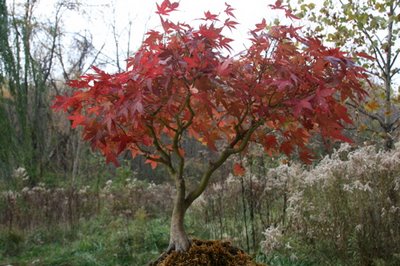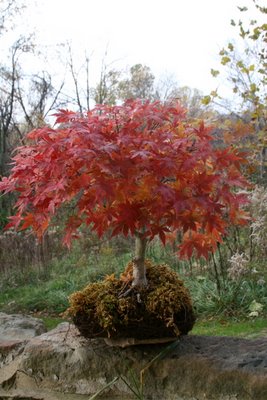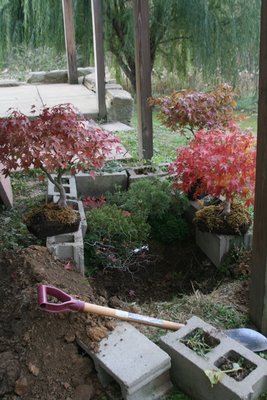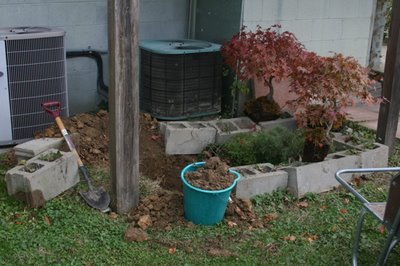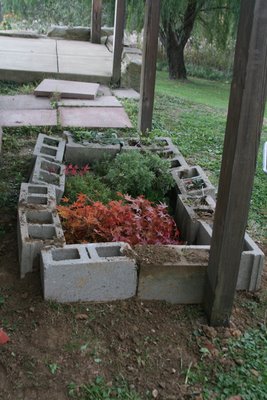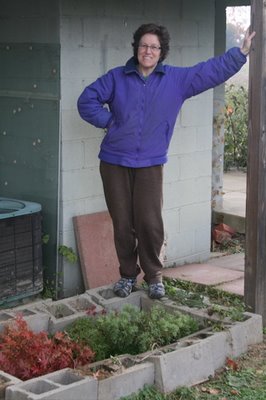Waking Sleeping Trees
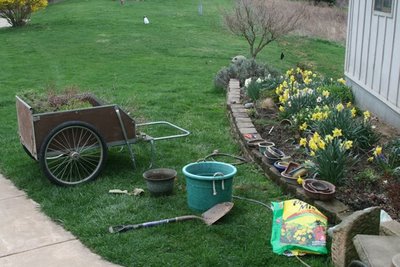
Picture Wayne and Garth wiggling their fingers in front of their faces, making time travel noises. We’re leaping ahead to spring, and for once I’m blogging about something that actually just happened in the last couple of days. April 10 is when I wake up my bonsais, drag them out of their snug little bed in the coldframe under the deck, and pot them up.
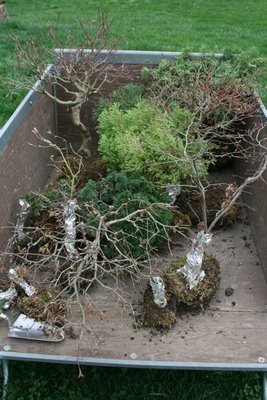 You can see the thick foil trunkwraps that discourage voles, who like to girdle decades-old bonsais. And why? Because voles are sick little animals. Foil hurts their fillings.
You can see the thick foil trunkwraps that discourage voles, who like to girdle decades-old bonsais. And why? Because voles are sick little animals. Foil hurts their fillings.First order of business is to mix up some soil. For bonsai trees, you need soil that drains well, but also retains moisture. The main problem on our windy dry ridgetop is keeping them moist in summer, and there are days when I water them twice. If you’re going to keep bonsais, you have to be around, and have someone you trust who’ll water them while you’re gone. These trees are so thirsty that it would be difficult to overwater them.
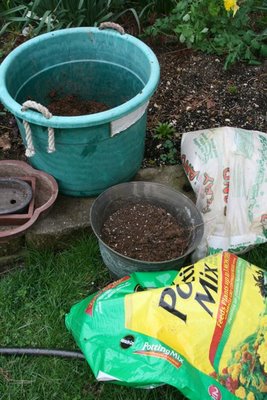
So I go to the woods and scrape up some nice humus, along with the clayey undersoil. I load as much of that as I can carry into my muck bucket, then mix it with storebought peat-based potting soil and some white builder’s sand. The peat helps retain moisture; the sand helps with drainage. I line up the pots and figure out who goes with which pot, kicking the rapidly growing smaller trees into larger pots each year. Then it’s time to trim the roots.
Ideally, a bonsai grower would trim the roots back all around the rootball by about one-quarter each spring. I can do that with most of my trees, trimming all around the rootball with a sharp shears. The idea is both to retard growth and to stimulate the production of new white “feeder roots” by trimming the old roots back.
In practice, it’s hard to do, because the roots get awfully dense and compacted, so I hack away as best I can. On this big old tree, the best I could do was lop off the bottom tier of the rootball. Nice form on this tree, if I do say so myself. It looks like a true miniature of a forest giant, doesn't it?
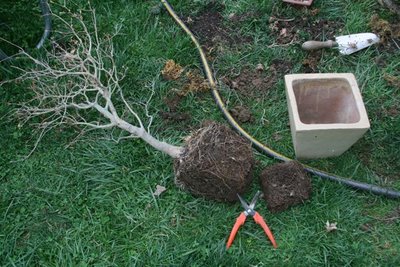 Some trees don’t need to have their roots trimmed every year: the chamecyparis and junipers grow much more slowly than the deciduous maples.
Some trees don’t need to have their roots trimmed every year: the chamecyparis and junipers grow much more slowly than the deciduous maples.I used to wash all the old soil out of the rootballs every spring, but I don’t do that any more, because I don’t like getting soaked and cold in early April.
Next, I chunk the trees back in their pots, with an infusion of fresh soil all around the outside where I’ve made room for it.
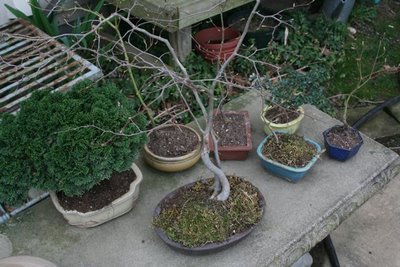
Now is a good time to trim any errant twigs and branches. It’s best to do these rather invasive procedures when the tree is just leafing out. Later, and you risk some bad wilting. It’s almost as if the tree has its mind so squarely on leafing out that it hardly notices the intrusion. The one caveat is: If the tree freezes after trimming, it can die. So I watch the weather very closely, and invariably I wind up dragging them all indoors a few times before it’s finally done freezing at night. Like, uh, tonight, and last night. Blaaa. I wanted to wash the foyer tile today but it was forested.
But I’m up against leaf-out, and I have to trim them before the leaves unfold, so I just sigh and schlep them around for a few weeks after I pot them up.
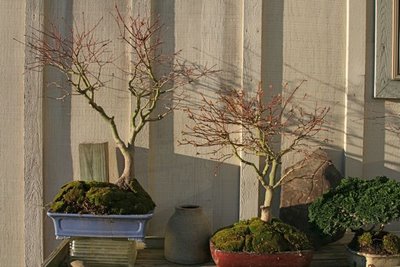 I get the moss to top things off right out of our lawn. Moss is vital; it keeps the soil from washing away, it keeps things moist longer, and it looks really pretty and finished, as if they've been growing here for years. The tree in the blue pot is the one I told you about that the coon split in two, that should be in a much more expensive pot, if you believe in such things.
I get the moss to top things off right out of our lawn. Moss is vital; it keeps the soil from washing away, it keeps things moist longer, and it looks really pretty and finished, as if they've been growing here for years. The tree in the blue pot is the one I told you about that the coon split in two, that should be in a much more expensive pot, if you believe in such things.Despite what mall and grocery store bonsai labels might tell you, true (non-tropical) bonsais are outdoor plants. You can’t bring them in the house for more than a day or two without stressing them. I break the rules in spring when they’ve just leafed out, and when they’re in peak fall color, and I’ll bring them inside for parties or dinners, but when the function’s over it’s right back outside. Bonsais are at their best in early spring and late fall. There’s no better conversation starter at a party or art show than a nice tree on your table.
I miss them over the winter when they’re all tucked in their beds. I’ve known these trees longer than I’ve known my husband or kids. It’s so wonderful to dig them back out in April, to see how they’ve fared over the winter, to wash them and trim them and pot them, to arrange them just so on the bench.
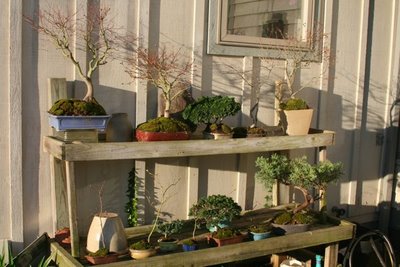
Labels: bonsai soil mix, cold frame for bonsais, Japanese maples, repotting bonsais, trimming bonsai roots

